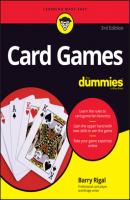Card Games For Dummies. Barry Rigal
Чтение книги онлайн.

Читать онлайн книгу Card Games For Dummies - Barry Rigal страница 15
Название: Card Games For Dummies
Автор: Barry Rigal
Издательство: John Wiley & Sons Limited
Жанр: Сделай Сам
isbn: 9781119880448
isbn:
At this point, you may not know whether to put the ♠A on the ♣A or on the ♠K because your piles don’t indicate whether you should keep aces or kings on top of your piles.
FIGURE 2-4: Playing the waiting game can help you make up your mind.
Now you can see daylight: Put the ♠J on the ♠A and then on the ♠K, and then you put the ♠J on the ♥J. Now you can combine the 9s. Next, put the ♠4 on the ♠J, allowing the ♣A to go on the ♣K and the ♦9 to go on the ♦Q. Put the ♠4 on the ♠7 to move down to three piles. Wasn’t that fun? Getting a series of moves to come together like that makes up for the hundreds of unexciting plays you go through.
Play continues until you end up with one pile of cards — good luck!
Piling It On in Calculation
Different people have different criteria for what makes a good game of Solitaire. The version called Calculation should satisfy most tests, because you can solve it in a fair amount of the time (so long as you work at it), it takes up little space, and you can devote your full attention to it or play without thinking — depending on your mood. However, unless you plan your plays carefully, the game will likely stymie you fairly early on.
In this game, only the card rankings matter — the suits of the cards are irrelevant. The object of the game is to build up four piles of cards on the foundation, from the ace on up to the king.
You begin by taking out an ace, 2, 3, and 4 from the deck and putting the four cards in a row from left to right, horizontally. These cards are the foundation on which you build — you hope — using the rest of the cards in the deck. Underneath those four foundations are precisely four waste piles, where you put cards that do not immediately fit on the foundation. Determining which pile to put those cards on is the challenging part of the game.
You build on each of the foundation piles one card at a time; however, you build up each pile in different sequences:
On the ace pile, you can only put the next ranking card — that is, the play sequence must go A, 2, 3, and so on.
On the 2 pile, you go up in pairs: 4, 6, 8, and so on.
On the 3 pile, you go up in intervals of three: 6, 9, Q, 2, 5, and so on.
And you shouldn’t be surprised that on the 4 pile, you go up in fours: 8, Q, 3, 7, J, 2, and so on.
For each of the four piles, you have 13 moves available. After the last move, you reach the king, and your piles are complete.
You turn up cards from the stock one at a time. If the card you turn over has no legal place, you put it directly on top of one of the four waste piles that you create below the foundation. As soon as the card becomes a legal play on a foundation pile, you may take the card from the top of the waste pile (but not from the middle of the waste pile) and move it up.
You arrange the waste piles so that you can see all the lower cards in them to maximize your strategic planning.
Kings are exceptionally bad news in Calculation. They’re always the last cards to go on each of the foundation piles, and when you put them on the waste pile, they can easily block everything beneath them. In a strange way, it’s good to turn up kings at the beginning of the game — you can put them on the bottom of each of the waste piles or put them all together in one pile.
Figure 2-5 shows an example of the start of a game. Having selected your ace, 2, 3, and 4 from the deck, you start turning over the cards one at a time.
FIGURE 2-5: A sample game of Calculation.
Reserving Your Time for Canfield
Canfield is one of the most commonly played Solitaires in the Western world. People often erroneously refer to this game as Klondike, which also appears in this chapter (see the following section, “Striking Gold with Klondike”). To further complicate matters, Canfield is also known as Demon Thirteen in the United Kingdom.
To set up Canfield, follow these simple steps:
1 Place 13 cards in a pile, with only the top card face-up; this pile is called the reserve or the heel.
2 To the right of the reserve, spread out four cards, called a tableau, on which you can build by using the cards from the reserve or the stock (the remaining 34 cards in the deck).
3 Above the tableau, place a single face-up card, which acts as the base card of a foundation from which each suit will be built up.
The object of Canfield is to get rid of all 13 cards in the reserve pile. You get rid of these cards by placing them in legal positions in the tableau.